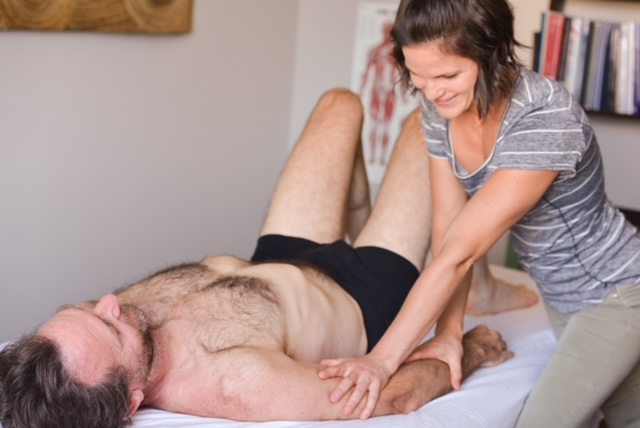
“Gravity is the therapist; when the body gets working appropriately, the force of gravity can flow through. Then spontaneously, the body heals itself.” – Dr. Ida P. Rolf
The Rolf Method of Structural Integration is a systematic method of bodywork which uses physical manipulation and re-educating movements to reorganize the body’s soft tissue within the field of gravity. But what does that mean?
First, the system referred to is the 10-session series which all clients undergo at the start of their Structural Integration process. Each session has a particular goal for a certain area or areas of the body. In general we want to create space and balance within and between the front and the back of the body, the left and right sides and from the inside of the body to the outside. We want to balance tissue around all sides of the joints so that they are neither too flexible nor inflexible; hyper-flexibility in one joint means hypo-flexibility in another.
Here’s a brief summary of each session:
Session 1
First the breath is opened up by working on all of the superficial tissue that could impede breathing. More breath means more oxygen to the entire system to aid the work of the following sessions. Time is spent on the arms, chest, shoulders and ribcage, as well as the top of the pelvis and hips to begin to bring more movement and balance to the pelvis. Every session concludes with neck and back work.
Session 2
The focus is on the lower legs and feet, giving a more even, solid foundation for the client. When the lower body is grounded into the earth, the upper body receives more support and is able to lengthen upward. The session concludes with seated back work to coax more length into the back.
Session 3
With the front and back bodies lengthened from the first two sessions, the sides of the body are now addressed, freeing the shoulder girdle from the thorax and creating a more harmonious relationship between the upper and lower body.
Session 4
Heading towards the deeper layers of the body, the goal of this session is to balance and lengthen the inner leg line, from ankle to inner groin. This creates a healthier pelvic floor, provides better support for the legs, and begins to release the tissue at the deep front of the lower back.
Session 5
This session is a continuation of session 4, bringing length further up into the abdominal core by balancing the rectus abdominis (the six-pack muscle) with the psoas (a hip flexor), further releasing the front of the lower back.
Session 6
Working up the back of the body, more space and movement in the pelvis is created, this time lengthening the back of lower back.
Session 7
With an open and solid foundation from the first six sessions, the neck and head is now be properly aligned and balanced upon this base of support.
Sessions 8, 9 and 10
In these integration hours, the focus is to make sure that all of the “cleaned up” areas previously addressed work well together, so that multiple joints moving at the same time function appropriately and as effortlessly as possible. Enhancing the client’s relationship in the field of gravity is also key.
What soft tissue is being reorganized?
The soft tissue in which Structural Integrators are particularly interested is the connective tissue called fascia. Fascia makes up the support system of the body, enwrapping every part of the body including muscles, groups of muscles, bones, nerves and organs. Repetitive stress, accidents, injuries, aging, and even emotional trauma can cause the fascia to shorten and tighten, thereby putting stress and limitations on the functions of our muscles, organs and the body as a whole. Often people compensate for these limitations in ways that just further misalign them and create imbalance in their bodies.
In SI sessions, Jessica uses her hands, forearms and elbows to carefully loosen and create more glide between layers of tissue, releasing adhesions between them and bringing vitality and proper movement back to the area. When the soft tissue is addressed in a systematic way, people become taller, straighter and move with greater ease and fluidity.
“Fascia supports and lifts weight. Weight goes up not down. Bones do not carry weight.”
– Dr. Ida P. Rolf
How does gravity influence body structure?
Gravity is a force that affects beings on earth constantly but is often forgotten. Because bodies are broader at the top than the bottom, gravity can easily take its toll when imbalances in the body exist. Imagine the body as a stack of blocks arranged on top of one another: feet, lower legs, upper legs, pelvis, ribcage, shoulder girdle, neck and head. The aforementioned stress and injuries can cause individual blocks, such as the pelvis for example, to shift, rotate or tilt, then causing the other blocks to adjust and fight the pull of gravity. Once the blocks relate optimally to one another around a vertical line, gravity provides support rather than pulling downwards. In Structural Integration, practitioners continually think about the body functioning within the field of gravity. They use this force as a tool in combination with small movements in seated and standing work to help the soft tissue find its way back to its appropriate home.
Who created Structural Integration?
Dr. Ida P. Rolf, who held a Ph.D. in biochemistry from Columbia University, spent the 1930s and ‘40s seeking ways to help her own and her family’s health issues which were unaided by traditional medicine. She explored multiple disciplines including osteopathy, chiropractic medicine, yoga and the Alexander technique. Through observation, experimentation and intuition she came up with the system of bodywork she called structural integration. It was in the 1960s that she began training other practitioners to do this work at Esalen Institute in California, and the first Guild for Structural Integration was formed and headquartered in Boulder, Colorado in 1967.
“The gospel according to Rolf is that you can’t get to the center to change it until you work with the outside. The body is like an onion. To get to the center without injury you must peel it layer by layer.” — Dr. Ida P. Rolf


